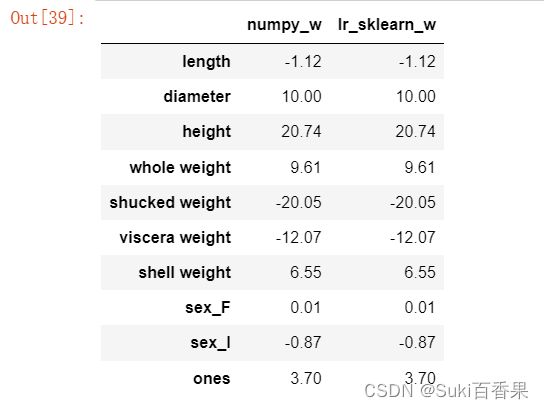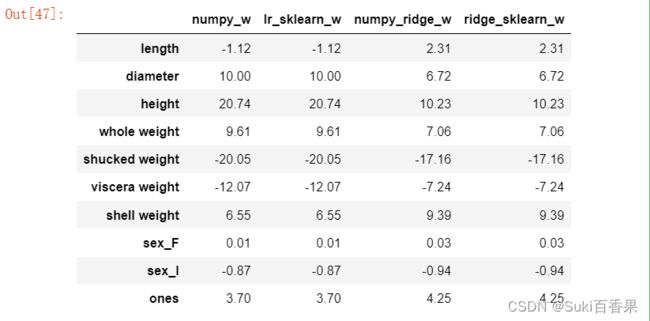鲍鱼数据集案例分析-预测鲍鱼年龄(线性回归/梯度下降法实操)
数据集来源UCI Machine Learning Repository: Abalone Data Set
目录
一、数据集探索性分析
二、鲍鱼数据预处理
1.对sex特征进行OneHot编码,便于后续模型纳入哑变量
2.添加取值为1的特征
3. 计算鲍鱼的真实年龄
4.筛选特征
5. 将鲍鱼数据集划分为训练集和测试集
三、实现线性回归和岭回归
1. 使用Numpy使用线性回归
2.使用Sklearn实现线性回归
3.使用numpy实现岭回归
4. 利用sklearn实现岭回归
四、 使用LASSO构建鲍鱼年龄预测模型
五、 鲍鱼年龄预测模型效果评估
1.计算MAE、MSE及R2系数
2.残差图
一、数据集探索性分析
import pandas as pd import numpy as np import seaborn as sns data = pd.read_csv("abalone_dataset.csv") data.head()#查看数据集中样本数量和特征数量 data.shape #查看数据信息,检查是否有缺失值 data.info()data.describe()数据集一共有4177个样本,每个样本有9个特征。其中rings为鲍鱼环数,加上1.5等于鲍鱼年龄,是预测变量。除了sex为离散特征,其余都为连续变量。
#观察sex列的取值分布情况 import numpy as np import matplotlib.pyplot as plt %matplotlib inline sns.countplot(x='sex',data=data) data['sex'].value_counts()
对于连续特征,可以使用seaborn的distplot函数绘制直方图观察特征取值情况。我们将8个连续特征的直方图绘制在一个4行2列的子图布局中。
i=1 plt.figure(figsize=(16,8)) for col in data.columns[1:]: plt.subplot(4,2,i) i=i+1 sns.distplot(data[col]) plt.tight_layout()
sns.pairplot()官网 seaborn.pairplot — seaborn 0.12.2 documentation
默认情况下,此函数将创建一个轴网格,这样数据中的每个数字变量将在单行的y轴和单列的x轴上共享。对角图的处理方式不同:绘制单变量分布图以显示每列数据的边际分布。也可以显示变量的子集或在行和列上绘制不同的变量。
#连续特征之间的散点图 sns.pairplot(data,hue='sex')* 1.第一行观察得出:length和diameter、height存在明显的线性关系
* 2.最后一行观察得出:rings与各个特征均存在正相关性,其中与height的线性关系最为直观
* 3.对角线观察得出:sex“I”在各个特征取值明显小于成年鲍鱼
#计算特征之间的相关系数矩阵 corr_df = data.corr() corr_dffig,ax =plt.subplots(figsize=(12,12)) #绘制热力图 ax = sns.heatmap(corr_df,linewidths=5, cmap='Greens', annot=True, xticklabels=corr_df.columns, yticklabels=corr_df.index) ax.xaxis.set_label_position('top') ax.xaxis.tick_top()
二、鲍鱼数据预处理
1.对sex特征进行OneHot编码,便于后续模型纳入哑变量
#类别变量--无先后之分,使用OneHot编码 #使用Pandas的get_dummies函数对sex特征做OneHot编码处理 sex_onehot =pd.get_dummies(data['sex'],prefix='sex') #prefix--前缀 data[sex_onehot.columns] = sex_onehot #将set_onehot加入data中 data.head()
2.添加取值为1的特征
#截距项 data['ones']=1 data.head()
3. 计算鲍鱼的真实年龄
data["age"] =data['rings']+1.5 data.head()
4.筛选特征
多重共线性
*最小二乘的参数估计为如果变量之间存在较强的共线性,则$X^TX$近似奇异,对参数的估计变得不准确,造成过度拟合现象。
*解决办法:正则化、主成分回归、偏最小二乘回归所以sex_onehot的三列,线性相关,三列取两列选入x中
y=data['rings'] #不使用sklearn(包含ones) features_with_ones=['length', 'diameter', 'height', 'whole weight', 'shucked weight', 'viscera weight', 'shell weight', 'sex_F', 'sex_I','ones' ] #使用sklearn(不包含ones) features_without_ones=['length', 'diameter', 'height', 'whole weight', 'shucked weight', 'viscera weight', 'shell weight', 'sex_F', 'sex_I'] X=data[features_with_ones]
5. 将鲍鱼数据集划分为训练集和测试集
#80%为训练集,20%为测试集 from sklearn.model_selection import train_test_split X_train,X_test,y_train,y_test = train_test_split(X,y,test_size=0.2,random_state=111)
三、实现线性回归和岭回归
1. 使用Numpy使用线性回归
#判断xTx是否可逆,并计算得出w #解析解求线性回归系数 def linear_regression(X,y): w = np.zeros_like(X.shape[1]) if np.linalg.det(X.T.dot(X))!=0: w = np.linalg.inv(X.T.dot(X)).dot(X.T).dot(y) return w#使用上述实现的线性回归模型在鲍鱼训练集上训练模型 w1=linear_regression(X_train,y_train)w1 = pd.DataFrame(data=w1,index=X.columns,columns=['numpy_w']) w1.round(decimals=2)所以, 求得的模型为
y=-1.12 * length + 10 * diameter + 20.74 * height + 9.61 * whole_weight - 20.05 * shucked_weight - 12.07 * viscera - weight + 6.55 * shell_weight + 0.01 * sex_F - 0.37 * sex_I + 3.70
2.使用Sklearn实现线性回归
from sklearn.linear_model import LinearRegression lr = LinearRegression() lr.fit(x_train[features_without_ones],y_train) print(lr.coef_)w_lr = [] w_lr.extend(lr.coef_) w_lr.append(lr.intercept_) w1['lr_sklearn_w']=w_lr w1.round(decimals=2)
3.使用numpy实现岭回归
def ridge_regression(X,y,ridge_lambda): penalty_matrix = np.eye(X.shape[1]) penalty_matrix[X.shape[1] - 1][X.shape[1] - 1] = 0 w=np.linalg.inv(X.T.dot(X) + ridge_lambda*penalty_matrix).dot(X.T).dot(y) return w
#正则化系数设置为1 w2 = ridge_regression(X_train,y_train,1.0) print(w2)w1['numpy_ridge_w']=w2 w1.round(decimals=2)
4. 利用sklearn实现岭回归
from sklearn.linear_model import Ridge ridge = Ridge(alpha=1.0) ridge.fit(X_train[features_without_ones],y_train) w_ridge = [] w_ridge.extend(ridge.coef_) w_ridge.append(ridge.intercept_) w1["ridge_sklearn_w"] = w_ridge w1.round(decimals=2)
岭迹分析
alphas = np.logspace(-10,10,20) coef = pd.DataFrame() for alpha in alphas: ridge_clf = Ridge(alpha=alpha) ridge_clf.fit(X_train[features_without_ones],y_train) df = pd.DataFrame([ridge_clf.coef_],columns=X_train[features_without_ones].columns) df['alpha']=alpha coef = coef.append(df,ignore_index=True) coef.round(decimals=2)import matplotlib.pyplot as plt %matplotlib inline #绘图 #显示中文和正负号 plt.rcParams['font.sans-serif']=['SimHei','Times New Roman'] plt.rcParams['axes.unicode_minus']=False plt.rcParams['figure.dpi']=300#分辨率 plt.figure(figsize=(9,6)) coef['alpha']=coef['alpha'] for feature in X_train.columns[:-1]: plt.plot('alpha',feature,data=coef) ax=plt.gca() ax.set_xscale('log') plt.legend(loc='upper right') plt.xlabel(r'$\alpha$',fontsize=15) plt.ylabel('系数',fontsize=15)
四、 使用LASSO构建鲍鱼年龄预测模型
LASSO的目标函数
随着增大,LASSO的特征系数逐个减小为0,可以做特征选择;而岭回归变量系数几乎趋近与0
from sklearn.linear_model import Lasso lasso=Lasso(alpha=0.01) lasso.fit(X_train[features_without_ones],y_train) print(lasso.coef_) print(lasso.intercept_)#LASSO的正则化渠道 coef1 = pd.DataFrame() for alpha in np.linspace(0.0001,0.2,20): lasso_clf = Lasso(alpha=alpha) lasso_clf.fit(X_train[features_without_ones],y_train) df = pd.DataFrame([lasso_clf.coef_],columns=X_train[features_without_ones].columns) df['alpha']=alpha coef1 = coef1.append(df,ignore_index=True) coef1.head() plt.figure(figsize=(9,6),dpi=600) for feature in X_train.columns[:-1]: plt.plot('alpha',feature,data=coef1) plt.legend(loc='upper right') plt.xlabel(r'$\alpha$',fontsize=15) plt.ylabel('系数',fontsize=15) plt.show()coef1
五、 鲍鱼年龄预测模型效果评估
1.计算MAE、MSE及R2系数
from sklearn.metrics import mean_squared_error from sklearn.metrics import mean_absolute_error from sklearn.metrics import r2_score #MAE y_test_pred_lr=lr.predict(X_test.iloc[:,:-1]) print(round(mean_absolute_error(y_test,y_test_pred_lr),4)) y_test_pred_ridge=ridge.predict(X_test[features_without_ones]) print(round(mean_absolute_error(y_test,y_test_pred_ridge),4)) y_test_pred_lasso=lasso.predict(X_test[features_without_ones]) print(round(mean_absolute_error(y_test,y_test_pred_lasso),4)) #MSE y_test_pred_lr=lr.predict(X_test.iloc[:,:-1]) print(round(mean_absolute_error(y_test,y_test_pred_lr),4)) y_test_pred_ridge=ridge.predict(X_test[features_without_ones]) print(round(mean_absolute_error(y_test,y_test_pred_ridge),4)) y_test_pred_lasso=lasso.predict(X_test[features_without_ones]) print(round(mean_absolute_error(y_test,y_test_pred_lasso),4))#R2系数 print(round(r2_score(y_test,y_test_pred_lr),4)) print(round(r2_score(y_test,y_test_pred_ridge),4)) print(round(r2_score(y_test,y_test_pred_lasso),4))
2.残差图
plt.figure(figsize=(9,6),dpi=600) y_train_pred_ridge=ridge.predict(X_train[features_without_ones]) plt.scatter(y_train_pred_ridge,y_train_pred_ridge - y_train,c='g',alpha=0.6) plt.scatter(y_test_pred_ridge,y_test_pred_ridge - y_test,c='r',alpha=0.6) plt.hlines(y=0,xmin=0,xmax=30,color='b',alpha=0.6) plt.ylabel('Residuals') plt.xlabel('Predict')观察残差图,可以发现测试集的点(红色)与训练集的点(绿点)基本吻合。模型训练效果不错。

























